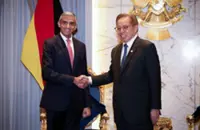Former foreign minister George Yeo said China needs to act in a way that shows the multipolar world it believes in is also good for the US. - ST
SINGAPORE (The Straits Times/Asia News Network): A multipolar world can be good for both China and the US, but both sides will have to work hard at achieving a peaceful transition to it, said former Singapore foreign minister George Yeo on Thursday (Dec 15).
“The US is not used to the idea of a multipolar world, but it is not necessarily bad for the US. In fact, I would argue that it will help extend the period of US ascendancy in the world, and in a good way,” he said.
Already a subscriber? Log in
Save 30% OFF The Star Digital Access
Cancel anytime. Ad-free. Unlimited access with perks.





